http://www.strategy-business.com/article/10208
Convergence and compression — these are the macro themes that emerge from our analysis of 10 consecutive years’ worth of detailed data on CEO succession among the world’s top 2,500 public companies. This rich database comprises 3,719 CEO turnover events globally. Looking across the decade, it is remarkable to see how turnover rates have converged across regions since we first began tracking them in 2000. The traits of new CEO appointments — the predominance of insiders, the split of the CEO and chairman roles, the growth of the apprentice model (in which the new CEO’s predecessor assumes the job of board chairman), the consistency of industry turnover rates — all are converging around new global norms.
Meanwhile, the compression of the role itself has become more noticeable, both in the data and in our ongoing conversations with CEOs around the world. This year, we conducted more than a dozen interviews with CEOs in the United States, Europe, South America, and Japan, and their remarks (captured in the second part of this article, “The Evolving Role of the CEO”) reaffirm the study’s conclusions: The tenure of a CEO is becoming shorter and more intense, the margin for error or underperformance is narrow, and the role of CEO increasingly excludes the job of also being chairman. On the other hand, the CEO increasingly engages with the board of directors, and also tends to have more opportunity to consult with the chairman. These sitting CEOs gave us rare insights into how the role has changed as a result of these pressures, and how they’ve managed to steer an effective course.
“It’s not the amount of work, but the sheer intensity of it,” notes Ian Livingston, executive director and CEO of telecommunications giant BT Group PLC. “It doesn’t seem to drop.”
“There aren’t many things I don’t feel both accountable and responsible for,” says Doug Oberhelman, CEO-elect of heavy equipment manufacturer Caterpillar. “I don’t think there’s any abdication of anything by the CEO on any subject.”
Not surprisingly, these trends of convergence and compression contribute to a high global churn rate among the world’s top CEOs. In 2009, CEO succession on a worldwide basis remained steady at the relatively high level of 14.3 percent, a level at which CEO turnover appears to have plateaued during the past five years. (See Exhibit 1.)
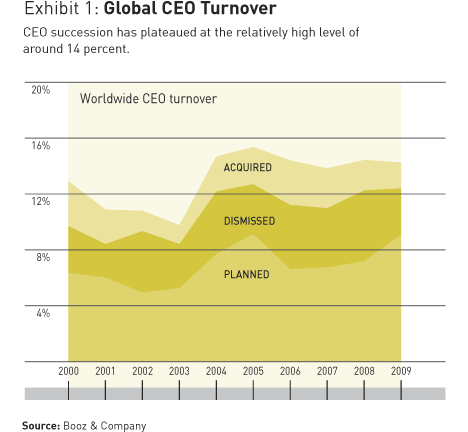
2009 at a Glance
In 2009, as economies around the globe bounced from rock bottom to incipient recovery, 357 new chief executives were appointed among the top 2,500 public companies. Of these succession events, 102 were located in North America (29 percent), 97 in Europe (27 percent), 49 in Japan (14 percent), 79 in the rest of Asia (22 percent), 18 in Africa and the Middle East (5 percent), and 12 in South America (3 percent) — which basically mirrors the relative numbers of top 2,500 companies in these regions.
The regional breakdown for overall turnover rates is largely consistent with that of the previous year, particularly in Europe and Japan. North American turnover declined from 14.8 percent to 12.4 percent. Europe was level at 15 percent. Japan, which experienced the highest regional rates of turnover in both 2008 and 2009, dipped slightly, from 16.9 percent to 16.4 percent. And the rest of Asia increased markedly, from 13.0 percent to 15.3 percent. Asia is increasingly dominated by companies headquartered in China. In 2000, companies based in China and Hong Kong accounted for 38 (1.5 percent) of the largest 2,500 public companies in our global sample. In 2009, that number stood at 220 (8.8 percent).
Planned successions (those in which the CEO retires or chooses to leave) constituted the bulk of turnover events, particularly in Japan (84 percent) and North America (71 percent). The number of forced turnovers (in which the CEO is typically removed by the board) declined region by region. Merger-related turnover was down on an overall basis, but was higher in Europe and the rest of Asia on a percentage basis. Both forced and merger-related successions were highest in Europe on an absolute and relative basis.
The most dramatic conclusions of this year’s study, however, are the clear and unmistakable trends of convergence and compression over the last decade — and the implications of these trends for newly elected CEOs, for executives who aspire to be CEOs in the future, and for other corporate leaders.
Convergence
The harmonization of CEO turnover rates suggests that global governance norms are emerging — not by fiat but through practice — across the world and in every industry. The percentages of CEOs who are replaced each year in Europe, as well as in the rest of Asia, have reached levels closer to those in North America and Japan. (See Exhibit 2.)
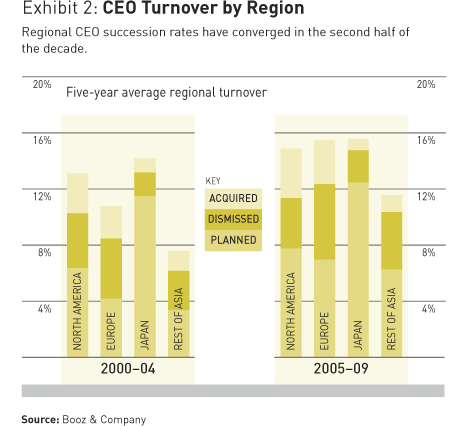
Similarly, CEO turnover rates have harmonized across industries. The 10-year averages all fall between 12 and 14 percent, with the exception of telecommunications (16.8 percent), which is a special case in several respects. (See “Telecommunications: The Exception to the Industry Rule.”)
The emerging norms for new CEOs include several noteworthy characteristics:
• A separate and overseeing chairman. More American and European companies are splitting the CEO and chairman roles. At the outset of the decade, roughly half of the North American and European CEOs entering office were named chairman and CEO. In 2009’s incoming class, that number had fallen to 16.5 percent in North America and 7.1 percent in Europe. (See Exhibit 3.)
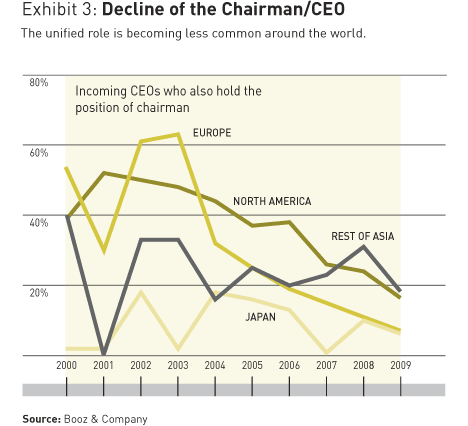
Having split the roles, companies in North America and Europe are increasingly appointing the outgoing CEO to the chairman post, with the incoming chief executive as the chairman’s “apprentice.”
Interestingly, the jury is still out on whether having a single-person chairman and CEO benefits or hurts company performance. (See Exhibit 4.) No one governance model consistently outperforms the other. But we know that the apprentice model — whereby the outgoing chief executive becomes chairman — does not produce consistently superior returns. In fact, apprenticed CEOs have underperformed non-apprenticed CEOs, on average.
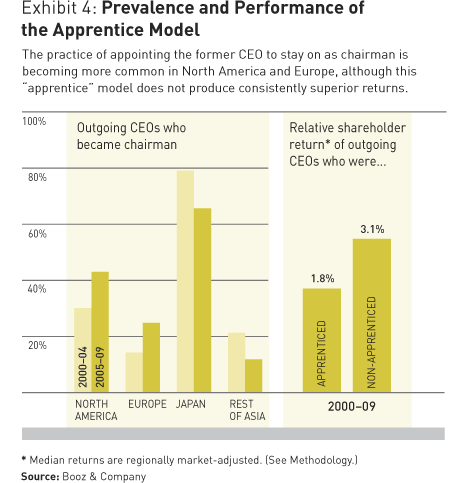
• A trend toward appointing insiders (for good reason). Four out of every five times, boards around the world choose insider candidates when selecting a CEO, and that ratio has been broadly consistent for 10 years — with relatively minor regional variations. On average over 10 years, the CEOs who departed from companies in Europe and the rest of Asia were insiders 73 percent and 72 percent of the time, respectively, compared with 80 percent in North America and 96 percent in Japan.
Insider candidates are naturally more knowledgeable about the company and the challenges and opportunities it confronts. They also tend to perform better and last longer, according to our research. Of the CEOs leaving office, insiders have produced superior regionally market-adjusted shareholder returns in seven of the last 10 years, averaging 2.5 percent; outsider-generated returns, in comparison, have averaged 1.8 percent. (See Exhibit 5.)
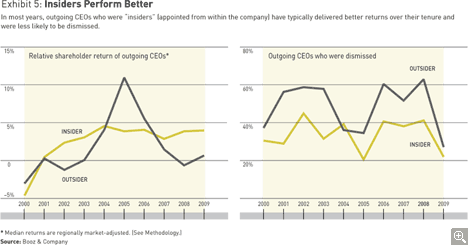
“There are many more advantages, I think, than disadvantages with everyone in the company knowing me and having access,” says Gregory D. Wasson, president and CEO of Walgreens, the leading drugstore chain in the United States. “There’s a trust factor that comes along with that.” Wasson joined Walgreens as a pharmacy intern in 1980.
Luiz Carlos Trabuco Cappi, CEO of Banco Bradesco, one of the largest private banks in Brazil, observes, “It was a bit easier for me, because I’ve lived in the company culture for 41 years. The key challenge was making more of the same — but better.”
To be sure, insiders lack the perspective that outsiders can bring. But the same relationships that enable trust, built over years, can also resist change.
“Coming in from outside has some benefits,” notes Jan Lång, president and CEO of Ahlstrom, a Finnish manufacturer of high-performance specialty papers and fiber composites. “It is easier to ask the challenging questions and not conform to conventional wisdom.”
Matti Lievonen, president and CEO of Finnish oil refining and marketing company Neste Oil, agrees, as does Neil M. Kurtz, M.D., president and CEO of Golden Living, an elder care provider. “Coming in without baggage does help,” says Kurtz, although he’s quick to add, “When you come in from the outside, it’s very difficult to build trust.”
As for tenure, our 10-year perspective confirms that insiders tend to last a good two years longer in the chief executive suite than outsiders (7.9 years versus 6.0 years). Outsiders are also more likely to be forced out of office than insiders; that has been the case in nine of the past 10 years.
• Experience and stability in turbulent times. It’s no accident that planned successions have been increasing for the past three years on a global basis. (See Exhibit 1.) In a time of economic upset and severely clouded visibility, boards have been loath to make sudden moves.
But the preference for stability and experience predates the recession. Boards have long sought seasoned CEOs, and, indeed, the percentage of outgoing CEOs with prior CEO experience in a public company has trended upward, more than doubling over the past 10 years, although that trend may have peaked in 2007. (See Exhibit 6.)
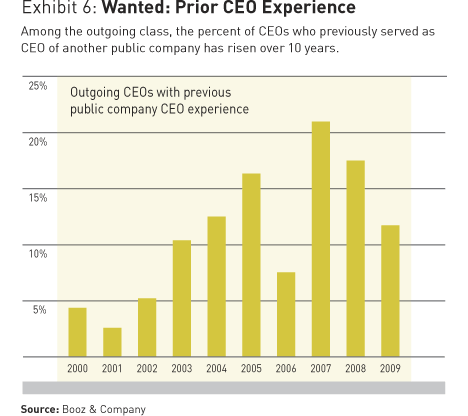
Compression
This trend toward convergence and stability might suggest that the nature of the CEO’s job is getting easier — or at least less pressured. But that is not the case. There is a simultaneous wave of compression reshaping and refocusing the job itself. Today’s CEO has more to prove in less time, and increasingly lacks the additional authority of being chairman of the board.
• The rise of the CEO-only role. As we’ve observed, CEOs no longer typically also hold the chairman title. Less than 12 percent of incoming CEOs in 2009 were awarded the chairman title, versus 48 percent as recently as 2002. In effect, the CEO’s job is concentrated on running the company, while the separate chairman is in charge of running the board.
• The poor performance reality. CEOs forced from office have significantly underperformed those who leave on their own terms. (See Exhibit 7.) In other words, contrary to the perception one might get from many press accounts, the tolerance for poor performance has gone down, further increasing pressure on the chief executive to put an agenda in place and produce results.
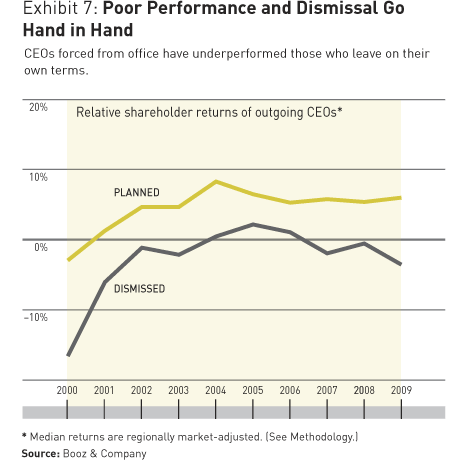
• The short time to develop and implement an agenda. CEOs in the 21st century must set a course and demonstrate results more quickly than CEOs of a generation ago. Although tenures of 10 to 15 years were not unusual in the latter half of the 20th century, the global mean tenure of departing CEOs has dropped from 8.1 years to 6.3 years during the past decade. (See Exhibit 8.) CEOs are leaving office at about the same average age as they have historically, but they were older when they entered office: 53.2 years old in 2009 versus 50.2 in 2000.
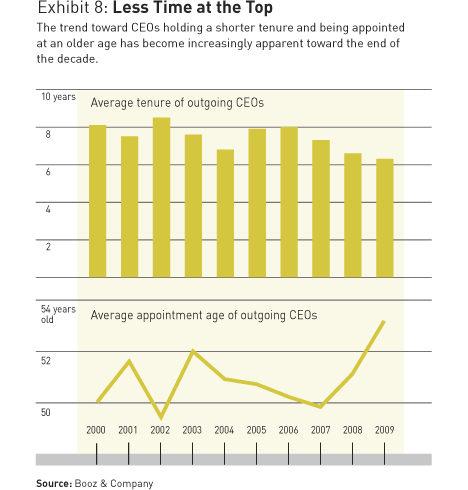
Implications of Convergence and Compression
As corporate governance norms have converged across regions and industries, they have become more rigorous and more codified, as has the demand for greater transparency from both regulators and investors.
One implication for CEOs, and those who might be CEOs in the future, is that the CEO’s role has grown exponentially more complex and intense. Another is that the job is more difficult to sustain. Shorter tenures and the increased incidence of planned succession mean that new CEOs will typically have fewer years to drive their agenda.
A third implication is that the increasing tendency to split the job of the CEO and the chairman means that each will be held more accountable than in the past. For CEOs, now more transparently responsible for the company’s success, the pressure for performance is increasing, and the time for producing results has shortened. For the chairman, more transparently responsible for board governance, there is more of an imperative — though less time — to prepare for succession, and the stakes for finding the right CEO successor are higher. The superior performance of insiders confirms the value of consistently supported and carefully designed leadership development programs; companies that are forced to look for an outsider may expect to pay a price in future performance.
The Evolving Role of the CEO
The trends of convergence and compression that emerged from our CEO succession studies over the past decade provide data about, and suggest implications for, the CEO’s evolving role. They also raise questions about how CEOs themselves view their role. How do they manage to move confidently over uncharted terrain? How do they strike the right balance between leadership and management? Between strategy and execution?
Based on our observations from the data and our own work with senior managements across a variety of sectors, we’ve identified four game-changing practices that can substantially contribute to success for new CEOs: Do only what only a CEO can do; engage with the board as a strategic partner; find the right pace of change, and get the culture working with you. As part of this year’s CEO succession study, we discussed these practices during in-depth, in-person interviews with 14 sitting CEOs in a variety of industries around the globe. We talked to them about the overall nature of the job, the unique requirements of the role, and the counsel they’ve received and would offer their successor, comparing their views with the results from our 10-year study. We have put their observations together to create a “virtual guide” to the evolving role of the CEO.
1. Do Only What Only a CEO Can Do
The CEO’s job, as we’ve noted, has become all-consuming, so it’s imperative that you delegate. Let others do the rest of the company’s work. The job of the CEO
is unique. You must be rigorous in selecting the issues you choose to address, and focus on doing what no one else can do.
Ian Livingston (BT): I think my job is to set the agenda, find the right people, and ensure that change happens. Only the CEO can do that.
Greg Wasson (Walgreens): A CEO has a larger institutional responsibility, focusing on shareholder value, driving EPS and return on investment. As a manager, you’re focused on P&L, whereas in this role, you’re absolutely focused on driving strong shareholder return.
Doug Oberhelman (Caterpillar): The bucks that you have to stop as CEO are very different in nature. There’s only one person that gets to adjudicate those. Sensitive international or inter-business issues are one. The way in which shareholders are treated is another. And big strategic changes in the company only come here.
• Shape the company’s definition of success. It’s up to the chief executive officer to articulate where the company is going. To rally your people around a coherent course of action, you need a clear recognition of the way people throughout the company define success now, so you can communicate effectively with them. And you need an even clearer articulation of where the company needs to go, so they can see how they need to change.
Severin Schwan (Roche): We took a very conscious decision to go for highly innovative businesses in very specific segments — pharmaceuticals and diagnostics. Our innovation is high-end innovation. If you want to be successful in developing new drugs, new diagnostic tests, and potentially integrating the two, you need to be absolutely cutting-edge. You need the best people in the world. If you are the second-best, there’s no market for you anymore. If I’m able to create an environment to which the most creative, most courageous, most innovative people are attracted, then I can sleep well.
Luiz Carlos Trabuco Cappi (Banco Bradesco): During the first month in the position, a team and I selected six keywords to guide the changes we wanted to implement. Those words — which included trust and colegiado [collegiality] — also reflected the most important aspects of our existing corporate culture. I also prepared and shared internally a personal commitment letter.
• Break the frame. Only the CEO can adjust the way the company defines its mission and its markets. This requires either changing fundamental aspects of the business model or challenging underlying assumptions. For example, the new chief executive of a consumer products company may have to replace the old practice of paying retailers to promote and, instead, price the company’s products with a new model that starts with direct consumer contact. Steps such as these can be perceived as threatening to entrenched interests within specific business units or functions. They can be initiated and sustained only at the level of the chief executive.
George Barrett (Cardinal Health): If you don’t come in with the notion that your frame might need to be broken, you’re not doing your job. You have to ask yourself, “Is there some advantage that I need to exploit relatively quickly — and can bringing a fresh set of eyes to this model enable me to do that?”
Jan Lång (Ahlstrom): Being able to step out of the box and rethink the business logic is critical, and the biggest challenge. The engagement with the board is critical in this process. Also, talking to people outside the company is very helpful. I find the strong cultural aspects of Ahlstrom a great asset to build from: honesty, trustworthiness. No doubt this is the legacy from its many years of family ownership. On the negative side, our asset base and footprint have overly shaped our thinking and actions. Breaking this perspective of the company is what is unlocking new potential. [Lång was recruited from outside; he came to this role in December 2008 after a six-year stint as CEO of Finnish plumbing and indoor climate solutions manufacturer the Uponor Corporation.]
Reinoldo Poernbacher (Klabin): Truly working with your team means engaging others on risk decisions, working toward finding shared solutions, and, if needed, disregarding organization structure in order to promote holistic views of the value chain.
• Reset expectations. A CEO entering office needs to create a new day in the organization by defining what specifically will change. The more succinctly and precisely you connect these changes to people’s expectations in terms of performance, accountability, and culture, the more likely it is that you will achieve the hearts-and-minds mandate that strategic change requires. Balance your clarity and boldness with a realistic understanding of what is possible in your organization. Your early proclamations should be delivered with conviction, but also with the recognition that they will have to evolve over time, as you and your staff incorporate the wisdom you acquire.
Kenichi Watanabe (Nomura): My mission as CEO is to create a series of changes inside the company, and the speed of that change is a very important factor, especially when market and business circumstances are changing so rapidly. The key to managing change is to make the organization realize we have no choice but to embrace it — we cannot turn away from it. However, it takes time for an organization like ours to change. We have a strong culture that was developed in a tightly regulated environment where most staff were employed for their entire career. One of my roles as CEO is to ensure that the organization is always alert to the direction of the external environment, agile in adapting, and moving quickly toward new goals, as I believe a strong organization is capable of transforming itself as it finds its place in the new order.
Doug Oberhelman (Caterpillar): I feel that if I personally move the pendulum toward authority through persuasion, then each of the leaders down the chain, without giving up the soft side of persuasion, will use authority to drive results. I do not want to move it all the way over. That’s not good, and that’s not our company and that’s not our culture. But we need to move from where we’ve been.
Roberto Medeiros (Redecard): Be transparent when you can, and be very open and sincere when you cannot be transparent — explicitly say you cannot talk about that topic and why, rather than making up an answer.
• Integrate the parts with the whole. Only the CEO can instill an enterprise-wide perspective in an organization, because only the CEO can reconcile and address the tensions that erupt between the whole and the parts. The individual parts of a company are predisposed to battle the centralized corporate function on the grounds that it consumes overhead, slows implementation, and doesn’t understand the customer. The center is predisposed to feel frustrated with the parts because they act on their own interests, fail to put the larger company first, and are reluctant to coordinate actions and goals.
George Barrett (Cardinal Health): I see this as both a push and a pull. The CEO needs to bring a point of view on how the glue that connects the enterprise makes it more valuable than the collection of the pieces. If it’s only “push,” however, chances are it won’t stick very well. When the organizational units start to “pull” for value and draw on the glue from the corporate center, that’s when powerful things can happen.
José Antonio do Prado Fay (Brasil Foods): In addition to mass communication, the CEO must be open to individual communication. I travel the country to meet with all our managers. I believe in “leadership by presence,” even though it is very challenging.
Kenichi Watanabe (Nomura): Since we acquired the operations of Lehman Brothers in Asia-Pacific and EMEA [Europe, Middle East, and Africa] in 2008, much of my time has been spent communicating with and motivating our senior managers around the world. It was a cross-border and cross-cultural integration. Managing a global business is not about enforcing historical Nomura standards or pursuing the Japanese way; it’s about doing what is most effective in the simplest and easiest way.
Severin Schwan (Roche): The good thing about [our acquisition of Genentech] is that — despite the differences — we share the same set of underlying values. We’re both very patient-oriented organizations, both very science-oriented organizations, both very people-oriented organizations, both very long-term-oriented organizations. That’s a lucky constellation.
2. Engage with the Board as a Strategic Partner
The most effective CEOs practice a corporate version of the Golden Rule: When engaging the board, do unto it as you would have your business units do unto you. Just as you want your business leaders to engage you as their strategic partner, keeping you informed of the good, the bad, and the ugly in a transparent fashion, so too should you engage the board. This is especially important if you are the CEO but not the chairman of the board.
In most companies in the past, CEOs kept the board at a distance, involving its members in strategy only at yearly off-site meetings. Given the pressure now being placed on the board, and the level of accountability expected from management, this approach is no longer sufficient; board members need to take part in the strategic conversation of a company as it develops. Otherwise, they may focus overmuch on risk mitigation, a hallmark of inexperienced or uninformed boards.
Neil Kurtz (Golden Living): A CEO’s job is to give his board actionable information.
Ian Livingston (BT): Trying to provide proactively clear information to the board is critical. Make sure you’re trying to get ahead of the game with them, that they feel genuinely that you are trying to let them in and not keep them out.
Greg Wasson (Walgreens): The board provides me with guidance and advice. I can’t imagine not having a positive relationship with the board — not being able to call one of them up and say, “Hey, here’s what I’m thinking. What do you think?”
Doug Oberhelman (Caterpillar): I’ve had multiple private conversations with each [board member] already, either over the phone or in person. I’m continuing to do that. I want to have a deep, face-to-face discussion on strategy, culture, organization, and individuals — and that brings a lot of things out. My objective has been to listen and then interject to make the points I want to make, and it’s been great.
Jan Lång (Ahlstrom): Boards play a different role today than in the past. They are more important in helping you strategize and are really there for you as a CEO. If you engage them appropriately, they can really help you sharpen your ideas and gain the courage to change course.
Severin Schwan (Roche): Franz Humer, our former CEO and now chairman of the board, is a great sparring partner for me. He and the board will take a challenging position and say, “Are you sure you want to do this?” That’s very important, because he knows the company very well, and he knows the key players very well, and the debate always improves the outcome.
Kenichi Watanabe (Nomura): The existence of an independent board is crucial for governance, since the management must justify their decisions and actions with rigorous analysis. This yields an effective checking function. It’s like a shareholders’ meeting on a monthly basis.
• Provide structure and processes. As CEO, you are responsible for leading the board to be bolder than it otherwise might be in challenging the company’s leadership and direction. The CEOs we have worked with accomplish this by putting in place an explicit structure and processes that guarantee continual board engagement.
José Antônio Guaraldi Félix (Net Serviços): I think the CEO must take the lead in building the relationship with the board — he must proactively schedule the board meetings, take notes of the decisions made and follow up on them, and solve conflicts.
• Build on the board’s expertise. Boards today provide complementary skills by design, with specific members offering expertise in specific areas, such as finance, compensation, operations, or markets. Your process of inclusion must be designed to leverage this expertise. At the same time, because board members often lack a deep knowledge of the business, you must provide them with the background they need to make a constructive contribution.
Neil Kurtz (Golden Living): The CEO can and should be very influential on the board. Boards want a CEO to come with a clear plan, a vision. A vision without a plan is a delusion. And then give them the information they need to carry out their fiduciary responsibility as board members.
Matti Lievonen (Neste Oil): The changes we have undergone have been very substantial; they would not have been possible without the guidance and unwavering support of the board. The board is also incredibly important as a sounding board. Without a fully trust-based relationship with them, it simply wouldn’t work.
3. Find the Right Pace of Change
Only the CEO can set the pace for change within a company: defining which changes must take place quickly and which will take time. Every CEO faces a learning curve; making premature pronouncements about forthcoming changes to the company’s business model, culture, and cost structure will create problems for you down the road. But moving too slowly can undermine essential momentum and provide competitors with an opportunity to pull ahead. Setting the pace is thus a judgment call that requires understanding how quickly your customers, competitors, and people can absorb and adapt to the new way of doing business.
In particular, as a CEO, you need to avoid setting unrealistic expectations about what can be achieved in your first 100 days. The first 100 days of your tenure will be important, as any honeymoon period might be, but your most critical initiatives will play out over the course of several years, depending on the goals and pace that you maintain.
Luiz Carlos Trabuco Cappi (Banco Bradesco): I don’t believe in 100-day plans. They are based on a fallacy. Whether the new CEO comes from inside or outside the company, he or she should focus on continuity. The challenge is how to renew the company, while ensuring continuity.
Neil Kurtz (Golden Living): [Julius Caesar said,] “Go slow to go fast.” Caesar wanted to attack the enemy on the other side of a river. And he asked his engineers to build the bridge slowly so he could cross the river quickly. You want to get certain things right. And then, you’ll be able to move a lot more quickly.
Greg Wasson (Walgreens): I don’t think I have the luxury of slowing down the pace of change. I think I have to focus more on how to manage it effectively.
Severin Schwan (Roche): Managing the pace has a lot to do with determining how much the organization can digest. If it’s people decisions, I think you have to do it rather fast. Do not wait too long if you don’t feel you have the right people in charge. If it’s more about developing a common culture, building trust, I think you can’t force this. Slow it down.
Matti Lievonen (Neste Oil): Setting the right pace of change is a challenge. First, of course, you need to think through the overall scope of change you are considering. The challenge is then to launch and address things in the right sequence and speed. The top team can take a lot of pressure and deal with it effectively. The challenge is further down in the organization where there is a risk of overstretching.
4. Get the Culture Working with You
In the past, CEOs typically thought of culture change in terms of such formal constructs as vision, strategy, programs, and structure — which are commonly expressed in codified documents, protocols, metrics, and charts. But a focus on just these formal aspects of an organization overlooks the importance of informal interactions: networks, peer-to-peer relationships, work norms and habits, information and resource flow, and communities of interest. A high level of emotional commitment is at the heart of a peak-performing organization; thus, making good use of these mechanisms is integral to achieving lasting change and stellar performance.
Jan Lång (Ahlstrom): Culture is very important; indeed, the softer questions have risen in importance. We spend lots of time assessing who we are and how we act.
Neil Kurtz (Golden Living): When you start, you get a certain sense of what the language of your company is, how certain words are used. And then you begin to institute your own language gradually. And for CEOs to be effective, they need to be very consistent in how they use words.
George Barrett (Cardinal Health): Language can be the most powerful symbol you have. It is easily repeated, and it spreads if the message is crafted thoughtfully. The role of the CEO is to speak in the language that rings true to the culture and strategy of the company.
• Build on peer connections. Leaders typically think of culture as synonymous withvalues. But it’s more useful to think of it as information, influence, and insights that flow among peers. Whether you have a strong or a weak culture often depends on the strength and caliber of these peer connections. For example, when peers spend time telling one another why specific changes won’t work, it creates negative momentum that can derail even detailed performance initiatives. In strong cultures, peers reinforce an innovative and positive response to change.
Matti Lievonen (Neste Oil): The behaviors you see are like the tip of an iceberg. There is so much going on underneath the surface that drives these behaviors, and you need to find ways to address it all.
Doug Oberhelman (Caterpillar): Culture is an absolutely ingrained, intertwined part of strategy. You can have the greatest strategy in the world and not be able to execute it because of poor culture. On the other hand, you can have the worst strategy in the world that a good culture will overcome.
• Leverage emotional power. As an incoming CEO, you cannot influence the culture by acting solely from your base of positional power. If you seek to move the organization in a new direction, you must respect, understand, and leverage the emotional power vested in your role by the people of the company.
Severin Schwan (Roche): In my experience, people really want to make their mark. If you ask people what drives them, it is not the money or the career opportunity, although that’s part of it. It is that they really can make a difference. Recently, I was at a company meeting in Frankfurt at which a Spanish lady, a patient with a once-debilitating disease, stood up to thank Roche for what the company had done for her. At that very moment, everyone in the audience knew why they worked for Roche. I knew why I worked there as well.
Building on a Decade of Change
Every CEO takes the helm at a particular moment in time, and the job is defined accordingly. Today, external forces and internal company dynamics are coalescing in unique and powerful ways across regions and industries. These forces are increasing the challenges facing new CEOs, including the greater pressure to perform and the compressed time frame in which to operate. But they also offer new CEOs a distinct opportunity to make a difference, by creating more clarity and greater transparency about what companies — and chief executives — are here to do.
The game-changing practices discussed here — doing only what only a CEO can do, engaging with the board as a strategic partner, finding the right pace of change, and getting the culture to work with you — provide a path toward success. Ultimately it is the CEO’s job to marshal people’s energy and capabilities in pursuit of a shared strategic purpose. Along the way, the new CEO may be the one to finally bridge the gap between the center and the individual businesses, to reshape the culture around new performance gains and strategic imperatives, and — even more important — to make a fundamental difference in the lives of thousands of people.
TELECOMMUNICATIONS: THE EXCEPTION TO THE INDUSTRY RULE
As part of our analysis, we segmented succession events by industry for each of the past 10 years, and found that, apart from the type of noise one might expect from random market movements, all of the industries displayed patterns broadly similar to one another and to the overall sample. There was one exception: telecom companies.
Telecommunications is an outlier in terms of both its 10-year turnover rate (16.9 percent versus an industry average of 13.6 percent) and its share of forced turnover (54 percent), which is the highest by far of the 10 industries assessed, and significantly higher than the 36.7 percent industry average. (See Exhibit 9.) Indeed, telecommunications is the only industry in which the incidence of forced succession is greater than that of planned succession.
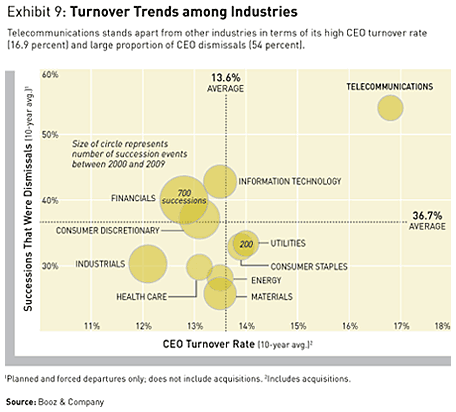
Likewise, telecommunications has not subscribed to the insider CEO norm; these companies have picked insiders only 53 percent of the time, versus an industry average (excluding telecom) of 81 percent. Interestingly, in the last two years, the telecom insider ratio has shot up closer to the industry average, suggesting convergence here as well.
Finally, telecommunications stands out for the compressed tenure of its CEOs over the past 10 years (5.2 years compared with a 7.5-year global average across all industries). It is not difficult to recognize the disruptive industry trends in the telecommunications industry as a root cause for this data. Shareholders of telecommunications service providers are obviously much less happy with the set of capabilities and the background experiences of their CEOs and senior leaders than are shareholders in other industries. One implication for telecom CEOs is the need to engage more proactively in skill building and talent hiring from other industries to strengthen their leadership bench. We believe that expertise is required, in particular from fast-moving consumer goods and Internet companies.



























































































